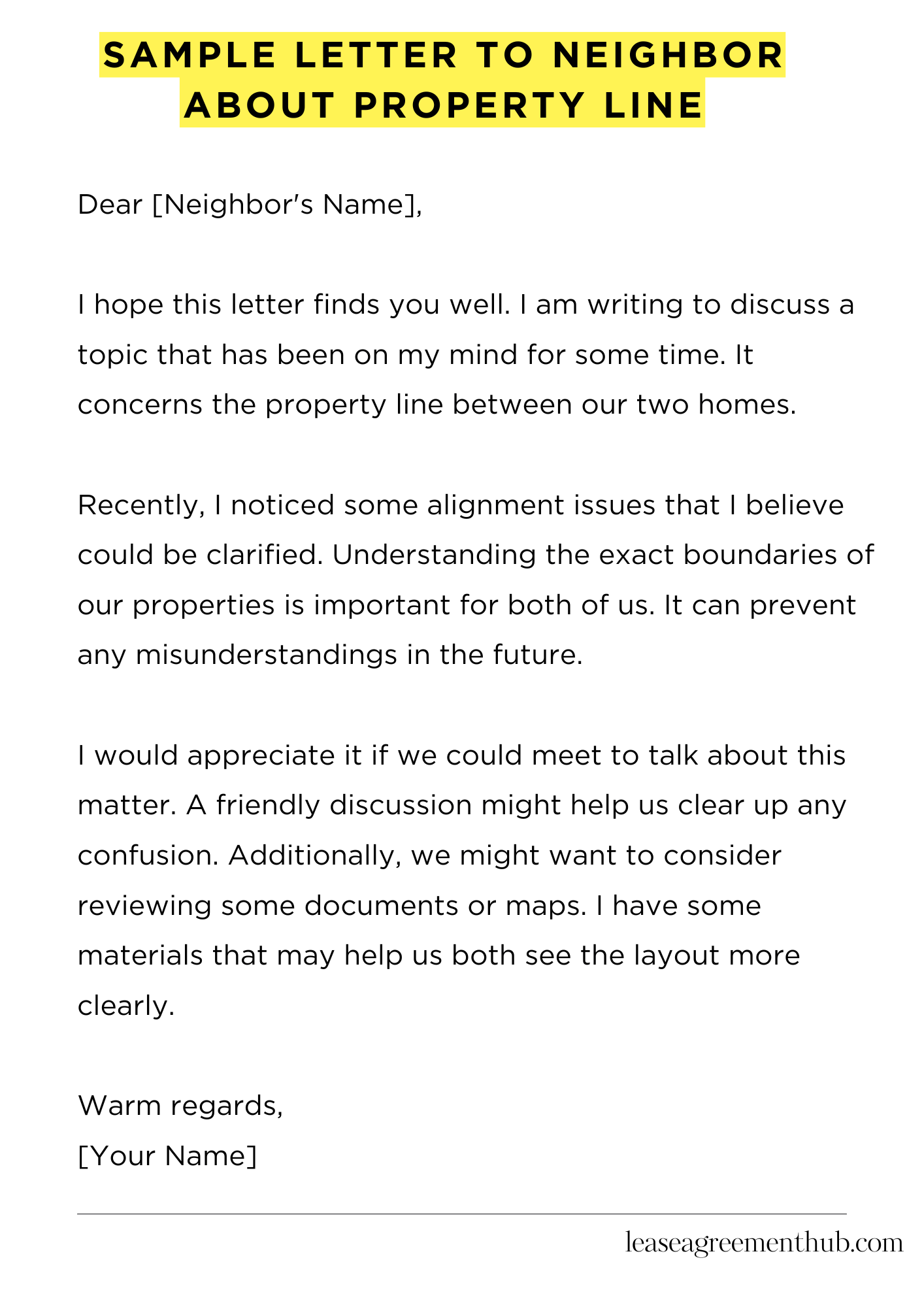A sample letter to neighbor about property line is a tool for homeowners who need to address boundary issues. Misunderstandings about property lines can lead to tension between neighbors. A clear and polite letter can help resolve these matters respectfully.
In this article, we will provide various templates and examples of letters you can use. Each sample is designed to make it easier for you to communicate effectively with your neighbor. Whether you are seeking clarification or addressing a concern, these samples will help you write the perfect letter.
Our goal is to simplify the process for you. With these examples, you can ensure your message is clear and courteous. Writing to your neighbor doesn’t have to be stressful.
Sample Letter to Neighbor About Property Line
[Your Name]
[Your Address]
[City, State, Zip Code]
[Email Address]
[Date]
[Neighbor’s Name]
[Neighbor’s Address]
[City, State, Zip Code]
Dear [Neighbor’s Name],
I hope this letter finds you well. I am writing to discuss a topic that has been on my mind for some time. It concerns the property line between our two homes.
Recently, I noticed some alignment issues that I believe could be clarified. Understanding the exact boundaries of our properties is important for both of us. It can prevent any misunderstandings in the future.
I would appreciate it if we could meet to talk about this matter. A friendly discussion might help us clear up any confusion. Additionally, we might want to consider reviewing some documents or maps. I have some materials that may help us both see the layout more clearly.
Please let me know a time that works for you. I am sure we can come to a peaceful understanding. Our neighborhood has always valued good relationships, and I hope we can keep that spirit alive.
Thank you for your attention to this matter. I look forward to hearing from you soon.
Warm regards,
[Your Name]

How to Write Sample Letter to Neighbor About Property Line
Understanding the Importance of Property Lines
Property lines delineate the boundaries of one’s land. They prevent disputes and misunderstandings between adjacent landowners. Grasping the significance of these lines is crucial before penning a letter.
Gather Necessary Information
Before composing your letter, collect all pertinent details. Consult your property deed, and obtain a survey if necessary. This knowledge fortifies your stance and enhances clarity in your communication.
Choose the Right Tone
Opt for a courteous and diplomatic tone. A neighborly approach cultivates harmony and encourages an amicable resolution. Avoid sounding confrontational or accusatory, as this can escalate tensions.
Structure Your Letter Effectively
A well-structured letter includes an introduction, the body, and a conclusion. Start by addressing your neighbor respectfully. Follow with a clear statement of your concerns regarding the property line, and conclude with a request for dialogue.
Be Clear and Concise
In the body of your letter, articulate your points with precision. Avoid convoluted language; simplicity often conveys your message more effectively. Ambiguity leads to misunderstandings, so be direct in your assertions.
Propose a Solution
Offer potential solutions or suggestions to resolve the issue. This might include sharing property surveys or arranging a meeting. Demonstrating a willingness to collaborate fosters goodwill and can expedite a resolution.
Review and Send the Letter
Once your letter is drafted, review it for clarity and tone. Ensure it embodies respect and understanding. After finalizing the content, send the letter promptly. Timely communication signals your commitment to resolving the matter amicably.
FAQs about sample letter to neighbor about property line
What should I include in a letter to my neighbor about the property line?
In your letter, include a clear identification of the issue, such as the specific part of the property line in question. Mention any previous conversations you’ve had, express your concerns respectfully, and request a meeting to discuss the matter in person if needed. Providing a map or survey can also be helpful.
How can I keep the tone of the letter respectful?
To maintain a respectful tone, use polite language, express understanding, and acknowledge your neighbor’s perspective. Frame your concerns as inquiries or requests rather than accusations, and emphasize your desire for a friendly resolution.
Should I mention any legal property documents in the letter?
Yes, if you have legal documents such as a survey report or deed that clarify the property line, it is wise to mention them in your letter. This demonstrates that your concerns are based on factual information and can facilitate a constructive discussion.
What should I do if my neighbor does not respond to my letter?
If your neighbor does not respond to your letter within a reasonable timeframe, consider visiting them in person to discuss the matter. If direct communication fails, you may want to seek mediation or consult a legal professional for advice on the next steps.
Is it necessary to send the letter by certified mail?
While it’s not strictly necessary, sending the letter by certified mail can provide proof of delivery and ensure that your neighbor receives it. This can be particularly important if the situation escalates and you need documentation of your communication efforts.
Related: